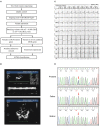Identification of a novel variant in N-cadherin associated with dilated cardiomyopathy
- PMID: 36111109
- PMCID: PMC9468813
- DOI: 10.3389/fmed.2022.944950
Identification of a novel variant in N-cadherin associated with dilated cardiomyopathy
Abstract
Background: Dilated cardiomyopathy (DCM), which is a major cause of heart failure, is a primary cardiac muscle disease with high morbidity and mortality rates. DCM is a genetically heritable disease and more than 10 gene ontologies have been implicated in DCM. CDH2 encodes N-cadherin and belongs to a superfamily of transmembrane proteins that mediate cell-cell adhesion in a calcium-dependent manner. Deficiency of CDH2 is associated with arrhythmogenic right ventricular cardiomyopathy (OMIM: 618920) and agenesis of the corpus callosum, cardiac, ocular, and genital syndrome (OMIM: 618929). However, there have been no reports of isolated DCM associated with CDH2 deficiency.
Methods: We performed whole exome sequencing in a 12-year-old girl with non-syndromic DCM and her unaffected parents. Variants in both known DCM-related genes and novel candidate genes were analyzed and pathogenicity confirmation experiments were performed.
Results: No pathogenic/likely pathogenic variant in known DCM-related genes was identified in the patient. We found a de novo variant in a candidate gene CDH2 in the patient, namely, c.474G>C/p.Lys158Asn (NM_001792.5). This variant has not been reported in the ClinVar or Human Gene Mutation Database (HGMD). CDH2 p.Lys158Asn was found in the conserved domain of N-cadherin, which is associated with the hydrolysis of the precursor segment and interference with adhesiveness. Furthermore, we tested the expression and efficiency of cell-cell adhesion while overexpressing the CDH2 Lys158Asn mutant and two previously reported variants in CDH2 as positive controls. The adhesion efficiency was considerably reduced in the presence of the mutated CDH2 protein compared with wild-type CDH2 protein, which suggested that the mutated CDH2 protein's adhesion capacity was impaired. The variant was probably pathogenic after integrating clinical manifestations, genetic analysis, and functional tests.
Conclusion: We identified a CDH2 variant in DCM. We observed a new clinical symptom associated with N-cadherin deficiency and broadened the genetic spectra of DCM.
Keywords: N-cadherin; cell-cell adhesion; de novo variant; dilated cardiomyopathy; whole exome sequencing.
Copyright © 2022 Chen, Sun, Hao, Guo, Wang, Yang, Zhang, Wang, Li and Guo.
Conflict of interest statement
The authors declare that the research was conducted in the absence of any commercial or financial relationships that could be construed as a potential conflict of interest.
Figures


Similar articles
-
Whole exome sequencing with genomic triangulation implicates CDH2-encoded N-cadherin as a novel pathogenic substrate for arrhythmogenic cardiomyopathy.Congenit Heart Dis. 2017 Mar;12(2):226-235. doi: 10.1111/chd.12462. Epub 2017 Mar 21. Congenit Heart Dis. 2017. PMID: 28326674
-
Identification of Cadherin 2 (CDH2) Mutations in Arrhythmogenic Right Ventricular Cardiomyopathy.Circ Cardiovasc Genet. 2017 Apr;10(2):e001605. doi: 10.1161/CIRCGENETICS.116.001605. Circ Cardiovasc Genet. 2017. PMID: 28280076 Clinical Trial.
-
De Novo Pathogenic Variants in N-cadherin Cause a Syndromic Neurodevelopmental Disorder with Corpus Collosum, Axon, Cardiac, Ocular, and Genital Defects.Am J Hum Genet. 2019 Oct 3;105(4):854-868. doi: 10.1016/j.ajhg.2019.09.005. Am J Hum Genet. 2019. PMID: 31585109 Free PMC article.
-
[A case of dilated cardiomyopathy caused by FHL2 gene variant and a literature review].Zhonghua Yi Xue Yi Chuan Xue Za Zhi. 2023 Mar 10;40(3):337-343. doi: 10.3760/cma.j.cn511374-20211230-01025. Zhonghua Yi Xue Yi Chuan Xue Za Zhi. 2023. PMID: 36854411 Review. Chinese.
-
Arrhythmic Phenotypes Are a Defining Feature of Dilated Cardiomyopathy-Associated SCN5A Variants: A Systematic Review.Circ Genom Precis Med. 2022 Feb;15(1):e003432. doi: 10.1161/CIRCGEN.121.003432. Epub 2021 Dec 24. Circ Genom Precis Med. 2022. PMID: 34949099
Cited by
-
Cardiomyopathy in children: a single-centre, retrospective study of genetic and clinical characteristics.BMJ Paediatr Open. 2024 May 31;8(1):e002024. doi: 10.1136/bmjpo-2023-002024. BMJ Paediatr Open. 2024. PMID: 38823802 Free PMC article.
-
Serum Pro-N-Cadherin Is a Marker of Subclinical Heart Failure in the General Population.J Am Heart Assoc. 2023 Mar 21;12(6):e028234. doi: 10.1161/JAHA.122.028234. Epub 2023 Mar 9. J Am Heart Assoc. 2023. PMID: 36892069 Free PMC article.
References
-
- Maron BJ, Towbin JA, Thiene G, Antzelevitch C, Corrado D, Arnett D, et al. . Contemporary definitions and classification of the cardiomyopathies: an American Heart Association Scientific Statement from the Council on Clinical Cardiology, Heart Failure and Transplantation Committee; Quality of Care and Outcomes Research and Functional Genomics and Translational Biology Interdisciplinary Working Groups; and Council on Epidemiology and Prevention. Circulation. (2006) 113:1807–16. 10.1161/CIRCULATIONAHA.106.174287 - DOI - PubMed
-
- Gerull B., Klaassen S., Brodehl A. The genetic landscape of cardiomyopathies. Cell Metab. (2019) 21:174–182. 10.1007/978-3-030-27371-2_2 - DOI
LinkOut - more resources
Full Text Sources
Research Materials
Miscellaneous

